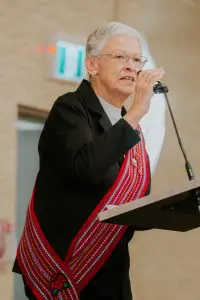Opinion: It's time for Calgary to remember its Métis roots
Posted on: Jul 10, 2025
Stampede celebrates Calgary’s heritage and western culture. The truth is, the city should also be celebrating and including recognition of its Métis roots.
When most people walk the Stampede grounds, they see grandstands, cowboy hats and the celebration of a Western legacy. But when I walk there, I see something more. I see the land where my family lived. I see the stories underneath concrete and fireworks. And I see a truth that’s rarely acknowledged: that the Métis were here.
We built lives, raised families, worked hard and then we were erased.
My family didn’t know the full story until the year 2000, but our roots in Calgary go deep. My grandfather, Daniel Vaness, was born in Calgary in 1885. My great-grandfather, Jean Baptiste Annouse-Vaness Jr., was born in 1856 and homesteaded land in Section 15, right where the Saddledome stands today. He was a fur trader and spoke multiple languages. He worked for the federal government as an interpreter, including during the signing of treaty, translating for the Blackfoot people.
These were not transient connections, they were foundational.
There were many Métis families living in the area around what’s now downtown Calgary. Métis families were pushed north to Tail Creek after many lost their land to the scrip system, a federal policy that was supposed to recognize Métis land rights but instead displaced thousands. Instead of honouring Métis title through treaties, the government offered scrip: paper certificates that could be exchanged for land or money, but only if individuals gave up their lands as Indigenous people.
The process was often corrupt, confusing and exploited by land speculators. Families like the Vaness, who married into my own, also lost their land through this system. Some of them are buried in a farmer’s field, land that was never returned or even recognized.
When we talk about Calgary’s history, where are the Métis?
Once, we were invited to showcase Métis heritage at Stampede. Just once. While I honour the stories and contributions of First Nations, their stories are not ours. Our own stories deserve to be seen and heard.
I worked downtown in the oil industry. I lived in Calgary for 37 years. Throughout my childhood, my family and I went to Stampede almost every year. My mom would sew Western outfits for the kids. We’d camp at Prince’s Island Park, and each of us would get 50 cents to enjoy the rides and snacks. My brother Danny became a saddle bronc rider. My husband and I square danced in three Stampede parades with the Calgary Star Dancers, managed by Martha Semeniuk and Dale Williams. My brother Leo once rode in a Red River cart with a live coyote and skunk while playing the guitar. My family and I are proud Calgarians and proud westerners, even if we weren’t always welcome.
This erasure follows lifetimes of discrimination. My parents married in St. Paul de Métis. My mother went to day school in Onion Lake, Sask. She was a perfectionist, always making sure we were clean and dressed properly, worried someone might come and take us away, making us hide when someone would knock on the door. That fear wasn’t unfounded.
My parents taught us how to protect ourselves, not by hiding our culture but by living it quietly. They didn’t teach us the language, but they taught us how to survive.
My family and I still go to the Stampede. There is a kind of magic this place holds for us. But it also holds pain.
I no longer want our culture to be lived quietly — especially not during Stampede. It’s time for Calgary to remember us. The Métis were here long before the city was founded. We’ve contributed to its economy, its culture and its identity. We’ve been hiding in plain sight for 150 years, not by choice but because we were made to feel we had to. That ends now.
We are still here. And we’re not going anywhere.
Doreen Bergum is the Métis Elder from the Battle River Territory